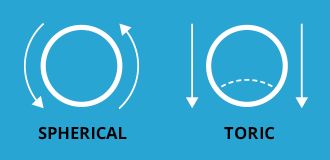Contact lenses for astigmatism: Toric, RGP and hybrid lenses

Too often, people mistakenly believe they can't wear contact lenses because they have astigmatism. The truth is, today there are plenty of excellent options for correcting astigmatism with contact lenses.
Here are the main types of contact lenses for astigmatism:
Toric contact lenses (soft)
The term "toric contact lenses" usually is used to describe soft contact lenses that are designed to correct astigmatism.
These toric contacts are made either of a conventional hydrogel material or a highly breathable silicone hydrogel material.

Spherical contact lenses have the same power in all meridians so it doesn't matter if they rotate when you blink. Toric lens power varies by meridian so they must remain rotationally stable. Some toric lenses are weighted at the bottom to prevent rotation.
Toric soft contact lenses differ from regular ("spherical") soft contacts that correct only myopia or hyperopia in two important ways:
Toric lenses have different powers in different meridians of the lens to correct the varying amount of short-sightedness or long-sightedness in different meridians of the eye that characterises astigmatism.
Toric lenses have a design feature that enables the lens to rotate to the proper orientation on the cornea so the power meridians of the lens align with the appropriate meridians of the eye for clear vision.
Every eye with astigmatism is unique, so it can take more than one pair of soft toric contact lenses to find the brand and design that provides the best fit, comfort and visual acuity.
Fitting toric contact lenses for astigmatism takes more expertise than fitting regular soft lenses. For these reasons, getting fitted with toric contact lenses may cost more than a regular contact lens exam and fitting.
As they have a more complex design, the cost of replacement toric contact lenses is higher than the cost of regular (spherical) soft contacts. The difference in cost will depend on the lens design, lens material, and where you purchase them.
Rigid Gas Permeable (RGP) contact lenses
Rigid gas permeable contact lenses (RGP contact lenses) are also a popular type of contact lenses to correct astigmatism.
In most cases, RGP contact lenses can correct astigmatism without a toric design. This is possible because gas permeable lenses are rigid and retain their spherical shape on the eye, instead of, as soft lenses do, conforming to the irregular shape of the cornea of an eye with astigmatism.
The uniform front surface of the RGP contact lens, in effect, replaces the misshapen cornea as the primary refracting (light-bending) surface of the eye, correcting the astigmatism without the need to control rotation of the lens with a toric design.
However, for higher amounts or unusual types of astigmatism, there also are gas permeable contact lenses for astigmatism that feature toric designs. In most cases standard RGP lenses correct astigmatism very well.
Another option is special large-diameter gas permeable contacts called scleral lenses, which provide excellent astigmatism correction even in cases of highly irregular corneal surfaces.
Many people with astigmatism who choose to be fitted with gas permeable contacts find their vision is noticeably sharper with RGP lenses than with toric soft contact lenses. However, due to the rigid nature and thicker profile of gas permeable contacts, these lenses typically take a little more time to adjust to. For some people it is too hard to get accustomed to the sensation of RGP lenses on their eyes.
Generally, fitting gas permeable contact lenses takes more time and expertise than fitting soft contact lenses (including toric soft lenses). And each RGP contact lens is custom-made to parameters specified by the prescribing optometrist. For these reasons, getting fitted with gas permeable lenses may cost more than getting fitted with soft lenses. The cost of purchasing replacement RGP lenses is also higher.
Hybrid contact lenses
For some people who need contacts for astigmatism, hybrid contact lenses are the best choice. These lenses have a central zone made of a rigid gas permeable lens material, surrounded by a fitting zone (or "skirt") made of a soft hydrogel or silicone hydrogel material.
When successfully fitted, hybrid contact lenses provide the best of both types of contact lenses for astigmatism — the very sharp vision of RGP lenses and comfort that's comparable to wearing toric soft lenses.
As hybrid contact lenses are about the same size as hydrogel and silicone hydrogel lenses (significantly larger in diameter than RGP lenses) and have thinner edges than gas permeable lenses, there is less risk of hybrid lenses being dislodged from the eyes during sports and other activities.
Fitting hybrid contact lenses — like fitting gas permeable contacts — takes more time and expertise than fitting soft contact lenses and like RGP contacts, these lenses are custom-made for each wearer's eyes.
Hybrid contact lens fittings and lens replacements are comparable in cost with those of rigid gas permeable lenses (in other words, more expensive than soft lenses), but like RGP lenses, hybrid contacts don't need to be replaced as frequently as soft contacts, making lens replacement costs more comparable to those of soft lenses over time.
Specialty contacts for astigmatism
Not long ago, the availability of soft contact lenses for astigmatism — especially soft lenses designed to correct high amounts or unusual types of astigmatism — was quite limited. No more.
Today, there are many brands and styles of toric soft lenses, including disposable contact lenses for astigmatism that are available in designs and materials for monthly, biweekly and even daily replacement.
There also are colour contact lenses with toric designs while enhancing or changing your eye color, and toric bifocal contact lenses that correct both astigmatism and presbyopia. There even are toric silicone hydrogel lenses designed for up to 30 days of overnight wear, and custom-made soft lenses that can correct virtually any type or amount of astigmatism.
See an optometrist
If you have astigmatism and want to wear contact lenses, visit an optometrist near you who specialises in fitting contact lenses for astigmatism.
During a comprehensive eye examination and contact lens consultation, your optometrist can tell you whether you are a good candidate for contact lens wear and which astigmatism-correcting contact lenses are best suited for your specific needs.
Page published on Monday, 16 March 2020






